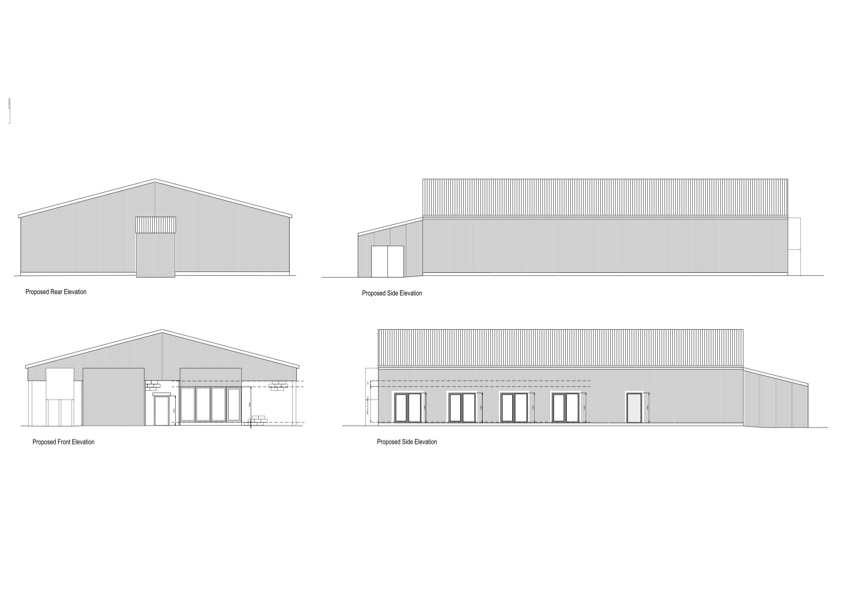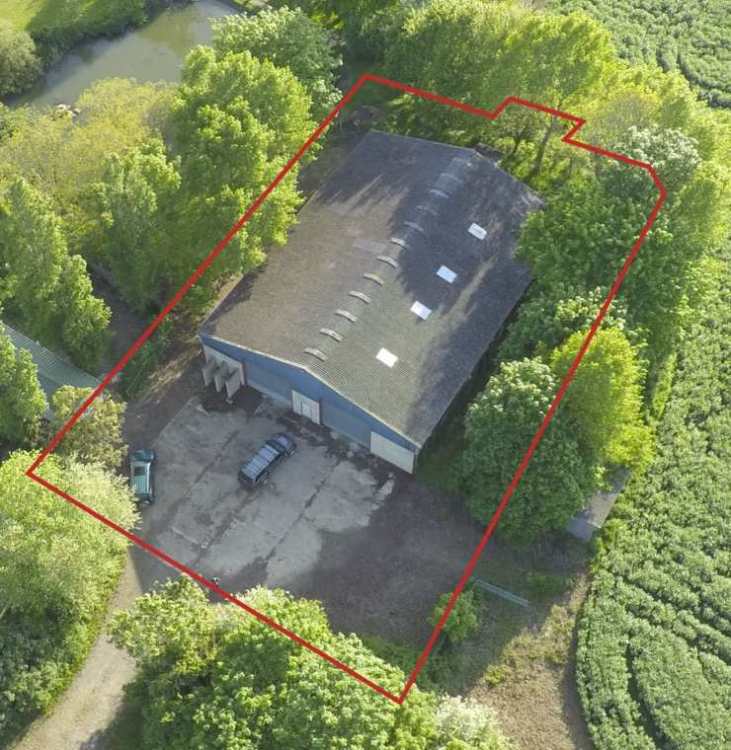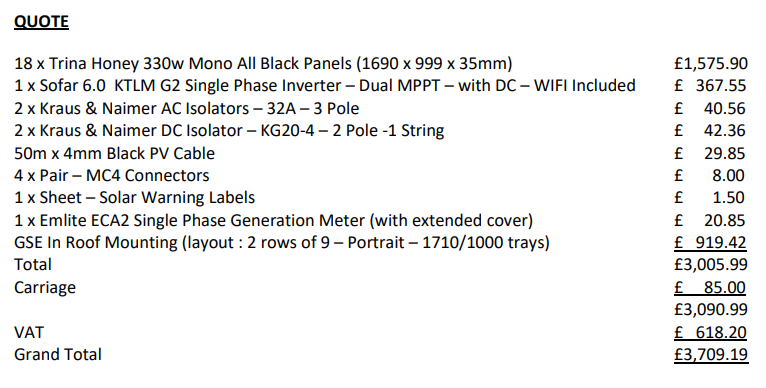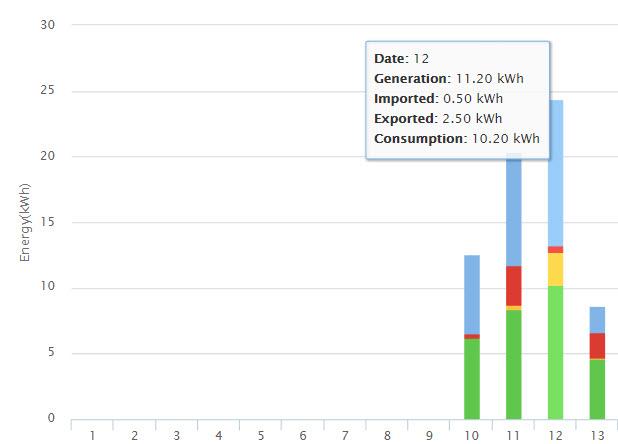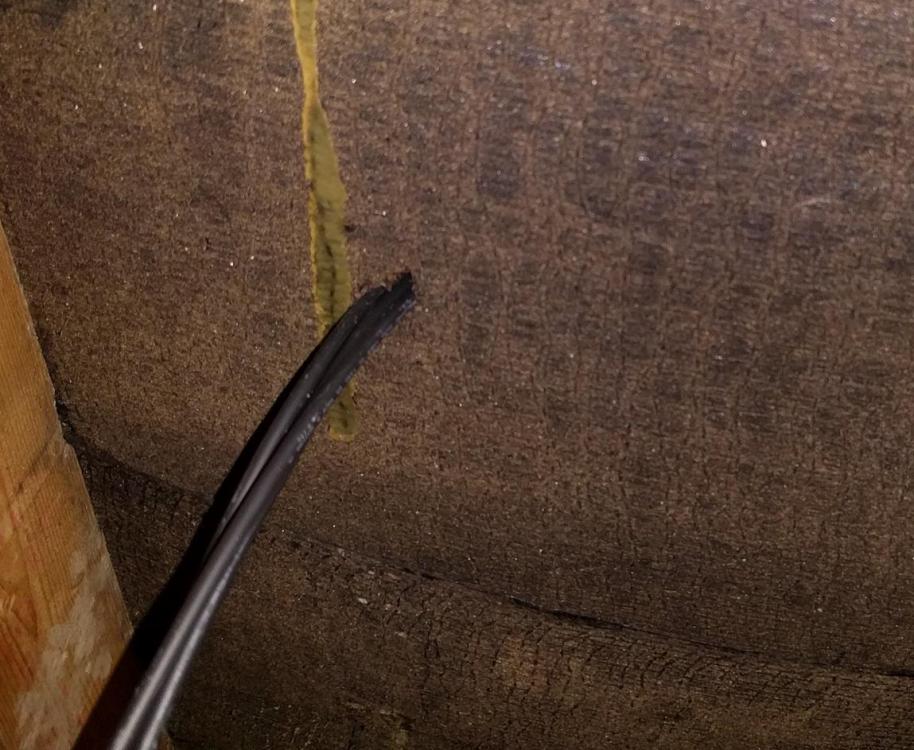Search the Community
Showing results for tags 'solar pv'.
-
Hi All, I hope someone sensible can help point me in the right direction or offer some useful comments on our project...! We'd initially planned to heat the whole place using an oil fired boiler with a wet system - underfloor tray system for the office space with warm air blower to keep frost off the warehouse space in the winter. But now we're wondering whether we can heat the office area appropriately with an ASHP throughout the year, possibly supported with PV panels on the roof? (It's a large roof, approx 250sqm is south facing, unobstructed - we can trim the trees). Outline as follows: We have a steel portal frame barn which we're converting into a warehouse with internal offices. The existing asbestos roof and steel sides will be replaced with insulated Kingspan panels (KS1000RW 100mm for roof and 73mm for the sides - both with U Value of 0.18 W/m2). The building measures 25m x 17.5m, average height is 5.25m. (see plans) Within the building is the office, which measures 8.3m x 15m x 2.6m. Ignore the additional small building on west side it's being demolished. When it's -3 deg C outside we'll need to maintain approx 10 deg C in the warehouse and 22 deg C in the offices. The place is only occupied during normal office hours. i.e. I'm not worried about keeping it warm at night, just that it doesn't freeze! We guess our heat demand would be approx 4kW for the office area and 16kW for the warehouse. (Maybe someone can tell me if this is miles off?). How can I work out how much energy an appropriately sized ASHP will USE across the year? Furthermore, we've got a great big roof area relative to the size of the office to be heated so can Solar be used to power the ASHP for most of the year? I guess in depths of winter when it's grey and wet the contribution would be minimal... at the time when the ASHP will be doing the most work and COP would be at its worst? What would a sensible output of PV be? Any advice warmly welcomed! Many thanks, Sven Proposed.pdf Floorplan.pdf birds eye.pdf
-
Sunday in the Highlands, and the weather has a feel of changing, we've been so fortunate on the build so far, day 105 today, but the last week or so has been wet, windy, sunny, overcast usually everyday. So autumn is on the way. July and August have been busy with the 2 cabins with around 100 nights occupied, that's over 250 people staying, and 30 +dogs 😂. The upshot being we can afford to eat, but the labour for the build has been affected with Mandy continually cleaning and washing. We've got a roof. Again the labour for all this is me and Mandy. The ICF allows the wall plates to be bolted to the core. Getting the trusses, 44kg, onto the roof was going to be by using a borrowed small loadall. We used this to take them off the truck and set them next to the house, but lifting them onto the walls was proving tricky with access and wind. So we resorted to leaning two lengths of 4x2 against the gable end , leaning 1 truss at a time against it and then sliding the truss up the 4x2 onto the wall plates. Then dragging them into place. We had a scaffold erected at 1 end of the house and used this to raise the first truss. Then it was repeat the process. Untill it was done. At either end of the house we used an additional truss to form a timber gable wall, this saved money on the ICF as we are having a cold loft. I drew the gable frame on CAD and created a cut list, then framed the gable out of 8x2 Insitu. I used 4x2 as a sub fascia to support the eaves trays, allowing the use of capit fascia boards keeping a keen eye on the budget🙈 I held off boarding as I had some labour debts to repay to the local farmer, and the wind was up and down. Once we had a clear window The roof and gables were boarded with OSB. At this time I also fitted membrane and battened / counter battened the gables. Black fascia boards, over fascia vents and eaves support trays were installed. The Highland vernacular is for small soffits / no soffit. So working back from the board on board cladding thickness and the battens I should end up with just the return on the fascia showing, about 30mm. I used some 4x1 as the sub soffit that will also act as a fire stop / smoke from entering the loft. Our location, and elevation suggests we can't use enough fixings for the tiles, we opted for Marley Edgemere thin leading edge tiles in anthracite. These were fixed at the eaves, every tile nailed and every tile clipped, more on this with the GSE trays. (Mandy back to real work🤣) I also taped the joints of the membrane with tyvek membrane double sided tape. We tiled the North elevation first as this was straightforward with only two roof vents (for MVHR) These were klober 25000mm2 universal vents as the Edgemere vents only ventilated to 10,000mm2. These are a good vent but it's a struggle with thin leading edge tiles to get them to sit flat. I ended up grinding a little of the back of the adjacent tiles and drilling an additional hole and nail to get them to sit as best as I could. There is a slight kick where the rubber flashing sits under the adjacent tiles but this doesn't affect the rows above, so decided I have to live with it. (Picture from a distance to stop you zooming the vents😂) The south elevation has 10 longi 405w PV panels, so I was using the GSE trays. Incidentally these trays and flashing were 50% more than the panels😔. GSE panels...... The instructions are very in-depth, but to be fair I just struggled with them. They suggest you don't need flashing for the top course as the tiles can sit over the trays, I doubt this works for any flat tiles / slates. Possible for pantiles if your lucky. A few on here @Dave Jones, and @dpmiller (I think) suggested this was the case, and I confirm you need the flashing kit, or use Flexi flashing, but IMO the detailing of the raised sections of the trays ( between panels) would be tricky and ugly. The thin leading edge tiles also caused slight kicking issues on the side flashing as well. So I had to be creative. (maybe this is standard for a proper roofer?) For the bottom flashing I used a 4x1 and timber wedges and used a replacement self adhesive flashing. Annoyingly the width of the trays with the raised section etc and the side flashings made the overall width 6.2M wide, so I had to order another length, and this was held up with Evri for 10days🥲. Fitting the extra battens for the clamps and tray support was painful for my brain, just too much timber. I ended up fitting a row of half trays at a time. Once the trays were fitted we tiled the RH side of the roof upto the GSE tray lateral flashing. This is where I needed to think out of the box, the tiles on there own kicked up into the air a looked terrible. I also had narrow tiles (120mm) cuts to allow for the half bond. These tiles needed the nib on the back of the tile grinding off which in turn meant they had nothing to hang on, and couldn't be nailed as they were on the flashing. So I used a hanging valley clip. To get these to sit flush I had to grind a little slot into the tile face, then to stop the tiles tipping into the flashing, and to give them a second fixing, I ground a groove in the rear of the tile, then once the next row was installed used a c clip to hold it all in place. Picture shows the valley clip and wire to hang the tile. Groove for C clip. C clip in place. This was repeated on all rows, so all tiles have at least two fixings. (Overkill?) The top flashing as I mentioned, had to be ordered and the corner flashings need modifying to ensure they sit flush over the PV panel. I installed two panels, then test fitted the flashing and corner flashing, which needed snipping with tin snips, then the overlapping cut edges pop riveted to reduce the height. This was sealed with lead mate. Once I fitted the flashings, I tiled the remaining roof and top rows. The flashing kit is expensive, but works and looks neat from the ground. Dry ridge installed,l and end caps finishing the roof. Then the panels, these were simple with 8 clamps per panel. Just the gutters to fit and scaffolding can come down. Some more EWI to fit then onto the windows and doors which are sat patiently waiting for us to pull our fingers out.
- 4 comments
-
- 3
-

-
- the windy roost
- highlands
-
(and 4 more)
Tagged with:
-
Morning All, So I'm on the feed in tarriff as i'm sure many of you are, from around 2016 time. Majority of us, me included would be on a deemed 50% export rate of around 5p/kWh. Obviously there is also the newer SEG which was introduced, and Octopus Energy take that even further by paying a fixed 15p/kWh or an agile rate based upon market rates. Now up until recently, I thought if you were to move to the SEG, you would have to give up your Feed In Tarriff, which would have been a big no-no, however I have since learned that you can split off your Export, leaving your Generation Tarriff fully intact. So I have signed up for Octopus Outgoing Agile, and they are currently creating me a new unique MPAN for export only. I'll give Agile a shot, and if it doesn't pay, i'll go for the fixed rate. Even with the battery storage i'm still exporting a lot, so this should pay dividends. Not sure if this is common knowlegde, or if i'm just a bit late to the party. https://octopus.energy/outgoing/ From their blog: Under FiT guidelines, you get paid for being a generator, and paid for whatever you export. You won’t be able to receive FiT export payments whilst also being on the Outgoing Octopus tariff. However, you will still be able to receive your generation payments. When you sign up to the Outgoing Octopus, you will be required to opt out of your deemed export payments from your existing FiT supplier (but there’s no requirement to switch your FiT contract to Octopus.) For new installations (that is, after the FiT closure date of 1/4/2019) we’ll still require a copy of your Microgeneration Certificate Scheme (MSC) certification in order to get you onto the tariff. 50% Deemed was one option under FiT for getting paid for your export. This is often the case where an export meter wasn’t fitted and so it is was assumed that 50% of the solar energy generated would be exported (the other 50% being consumed). This is calculated from the installed potential output of the solar panels at the time of install. You may find you are still better off keeping the Deemed 50% than switching to Outgoing Octopus - for example if in fact you are exporting only 20%, or if the solar panels aren’t optimally oriented to supply the potential output or have deteriorated over several years. As the FiT Export rate is now 5.38pence and our flat rate is 15 pence then you are better off with Outgoing Octopus if (average over the year) you export more than around 50% of the installed capability. Hope this helps someone out there!
- 5 replies
-
- 1
-

-
- solar pv
- feed in tariff
-
(and 1 more)
Tagged with:
-
Hi Folks! Having used BuildHub as a learning resource for a little while, I've pulled my finger out and got a sign-in. After a year of getting our ducks in line, we are about to apply for planning for a home on our smallholding in Somerset. It may be on the optimistic side, but we are aiming for an off-grid build, to passive house standards (intending to get certified), primarily from sustainable materials. The design is very close to complete now, and the next stage for us is to put our plans in front of a design review panel. Part of the reason for this, is that our planning application will be made under paragraph 80e (previously paragraph 79, before that paragraph 55). (A national planning policy, first established in 1997, which sets out various circumstances which can enable the erection of new isolated dwellings in the open countryside.) I understand that getting a good report from the design panel is a significant step towards success with this planning route. The fundamental plan is to try and build: A 4 bed detached home Concrete-free foundations Using load-bearing straw bale construction technique To achieve an overall carbon negative construction Off-grid A large PV array Several large lithium batteries for storage Bore hole for water WETs system to process grey/black water Achieving passive house certification We still have a lot to figure out, but I'm learning more every day. Thanks for everyone on here for contributing to BuildHub as an information resource.
- 62 replies
-
- 1
-

-
- straw bale
- off-grid
- (and 8 more)
-
Hi all, We are looking for opinions and advice on the systems we have currently specified for our build. It’s a near-passivhaus build, with MBC timber frame on an insulated raft foundation. Our predicted SAP rating is 102. The Primary fuel will be electric, there is no gas in the village, and we don’t intend to install LPG or Oil. We plan on having a large solar array (just waiting to DNO approval at the moment) and Tesla Powerwall – using the Octopus Tesla Electricity tariff, so power diverters and smart energy management are off the cards. We are looking at having a Sunamp Heat battery, in place of a hot water cylinder, and heating the house will be Ground floor UFH, and potentially using the MVHR air. We would like to run the ASHP in reverse in summer to cool the ground floor slab and the MVHR – but would still need to run it forwards to charge the heat battery. The Sunamp would be the HP version, which has primary input of (High Temperature) ASHP, and a backup option of mains electricity. This suggests 2 possibly options for Hot water in summer: 1) Run the ASHP in Heating mode when necessary to charge the Sunamp – and disconnect the UFH and MVHR art this point 2) Always run the ASHP in cooling mode when actively cooling, and charge the Sunamp from electricity (surplus from the solar in summer). Sunamp specify ASHPs to work with the heat battery, one being the Valiant aroTherm which is reversible. We wonder if anyone has done this sort of configuration and can offer advice on how they achieved it / information on how it has performed. Is there a valve / manifold product available that could handle isolating the output of the ASHP from the Sunamp or the Heating elements depending on which mode is being used on each? Our main concern at the moment is that we like a cool bedroom (17 – 18 degrees) and want to make sure we can achieve this year round with the systems we install. Here is a simple diagram of the system we are trying to describe with this post.
-
My pv solar system (Dec 2015) uses Solar Edge units on each panel for optimisation, and Solaredge inverters.. When installed it came with monitoring via the Solar Edge online portal. The company who installed my solar PV got out of it some time ago, and logging back in using the original details I see that monitoring is no0t happenng. Does anyone know if I can get that up and running again, or do I need to switch to a third party type standalone meter? Any similar experiences? Thanks Ferdinand
-
Hi, I'm looking for design guidance and recommendations for best Inverter & storage options for a DIY install as part of a new house build. Im not looking for an MCS FIT approved system but just to get maximum benefit from solar PV at lowest cost and would like the capabilitty to run off battery power during the evening and ideally during a power cut. I have a qulaified electrician ready to connect up the system, but I'm a bit confused by all the options. So far I have purchased 24 x Canadian Solar 370W panels (Model: CS3L-370MS-MC4-F30), which is the maximum I can fit on the south facing roof arranged as a 3x8 array. Roof is being tileds now so need to finalise the design asap to allow panels to be installed. Mains supply is single phase and I have checked with my local network provider that they are OK with me connecting a 9Kw array to the grid. Budget is tight so need the option to add additional batteries at a later stage. Any suggestions on best combo of Hybrid Inverter and storage would be really helpful.
-
Hi, does anyone know (for certain) whether retro-fitting battery storage (AC coupled) to an existing Solar PV Installation that benefits from the old FIT requires the installer of the battery to be MCS Certified so as not to compromise the FIT payments? ...or can anyone point me to where it is confirmed either way?
- 15 replies
-
- mcs
- energy storage
-
(and 6 more)
Tagged with:
-
Have quite a long drive and approximately 2m tall retaining wall. Looking for solar powered down lighting similar to street lights. I may need to extend upwards to get lights at correct height but that ok. I really want to install solar powered only, but need decent performance in winter. Panel size shouldn't be an issue as I have loads of space on a south facing part of the hill. Anyone using anything they can recommend?
-
Hello, We already have a 6.3kw PV array on the house with battery storage. We are wondering if it would be viable to add a further 4 panels, about 1.4kw, onto the garage roof. The garage has a 2.5mm underground feed from the house and a small CU. I believe we could use the existing cable to feed the garage generation from the inverter back to the house but that it could not be recorded on our fits meter or utilised to charge the batteries. Can anyone confirm that is the case? Also if we decided to run a new cable from the new garage inverter to the house and via the fits meter, a distance of about 30metres, would there be a noticeable voltage drop ? and what size cable would be best?
-
Hi All, I hope you're keeping well! I just wanted to introduce myself 'Joe' to the forum as I have been a long time reader and now hopefully getting closer to starting my own build. The forum is such a great resource for information and the knowledge of the users is simply amazing - I really do appreciate everything I have read here as it has helped me so far on my journey. I am hoping to learn as I go and all being well, I'll be able to help others as I pass through each stage of the build and gain my own knowledge and experiences. The house is a two story house with a connection to single story building for the kitchen, dinning and living area which in total is approx 330m2 sitting on 0.8 of an acre. It will have a ground source heat pump, with underfloor heating on the ground and first floor, mechanical ventilation heat recovery system and a PV solar array with battery. Windows triple glazed throughout. The current SAP report SAP rating: 92 A Environmental: 93 A If I have missed anything I will update the above. All the best, Joe
-
I can get up to 18 panels on the south facing roof of my self-build and I'm looking to finalise my solar pv system specification and pricing. Below is the first quote I've received for supply of a 6kW system in response to my outline specification (i.e. up to 18 panels, all black, in-roof mounted): Would appreciate advice on the suitability of the specification and the items included. Anything in here that I should definitely not use? Does the pricing look reasonable? Where else should I be looking to buy the solar pv system from? TIA
-
Hi there. We're upgrading our sixties house in Sussex with a GSHP, underfloor heating and a new hobby room (separate building) with a goodly chunk of solar PV to go onto its roof. The hobby room will have a separate ASHP. The insulation in the house has also been improved. We've done most things in the house but the new hobby room is yet to be built (we have planning permission) and we're just at the stage of re-wiring the existing house. Octopus have installed a three phase smart meter, although we only have two phases to the house (and that ain't gonna change). Stumbled across this site and wonderful forum when searching for how the importing and exporting of power is going to work with two phases, potentially phases both generating and using power. Any experience or knowledge in that area gratefully received! Cheers UncleK
-
I am in the process of designing (with architects!) and commissioning a small low-energy house which will rely mainly on solar pv for energy. There is no gas at the property. I have over 15 years experience of solar thermal and solar pv. My current house uses solar pv exclusively for hot water for more than 7 months per year, uses gas for ch & backup hw for colder months. My current 3 immersion design cylinder has proved very effective. I have trawled through various heating and dhw designs including thermal stores and multi-tank solutions but cannot reconcile the different requirements (eg thermal stores need a good temperature gradient to provide dhw - heat pumps provide 55º as a working maximum). I have also noted comments on this forum. (“Hot water and heating are different – keep them separate!”) However I’m still looking for an efficient & effective solution. I am considering using a large unvented cylinder (say 500 litres) which will also act as a buffer for a heat pump and a thermal store for underfloor heating. For at least 8 months of the year the total input would be from solar pv through immersion heaters. For the colder months there would be the possibility of input from a heat pump. Primary heating would be through 3 immersion heaters. I have included a diagram. I see the following as advantages : 1. A single tank with straight-forward plumbing. No complex valves or diversions. 2. Separation of circuits for input/output. Antifreeze needed only in the heat pump circuit. - Better heat transfer to UFH with water than with antifreeze mixture. (and much less of it) 3. Ability to maximise use of solar pv (8kW) throughout the year. 4. Possibility of running as a fully electric system without heat pump - under consideration for at least one year to assess relative costs. Also provides alternative heating if heat pump fails. 5. Typically : we boost heat in the mornings (before 9.00) and in the late afternoon/early evening. Background temperature maintained at other times (although with a good store in the slab this will become less pronounced). Best efficiency from an ASHP will be when the outside temperature is highest and the best use of solar pv will be between 9.00 and 17.00. So having a facility to store heat at these times will maximise both efficiencies. I recognise one potential problem: In our current location, with excessive water hardness, cylinders frequently deposit more than 0.5kg calcium salts per year. We have completely avoided this by quality water softening and would do so in the new location. Although the physical design is simple the efficiency will depend on the control circuits. I propose to design & program these myself rather than rely on the current commercial provisions which seem to be over-complicated but still limit options to those provided by manufacturers. All of the plumbing would be installed by G3 qualified tradespeople. So I would welcome constructive guidance … 1. Is there any commercial system which already follows these lines which I’ve missed? 2. Has anyone on this forum taken a similar line – with what results? 3. Are there any genuine down-sides which I’ve missed?
- 11 replies
-
- uvc ( unvented hot water cylinder )
- buffer tank
-
(and 2 more)
Tagged with:
-
With the big reduction in the feed in tariff it seems like you need to use any power generated to gain any benefit from the PV panels, or add yet more kit like batteries to use at a later time. This is a big investment and with limited winter sunshine, when supply demand is highest, does solar PV still make sense for a typical 4 bed home? Or can I use the money saved in a better way to keep energy demand down perhaps?
-
My planning permission contains commitments for installation of solar PV, air-source heat pump and rainwater harvesting. I'm not wanting to go through another round of planning variations so I will install them. However, I suspect if I'd done a full cost benefit analysis then it would be difficult to justify the rainwater harvesting in particular. The solar PV hardware appears to be getting much cheaper (haven't looked at install yet) but the Smart Export Guarantee tariffs don't look particularly attractive (5.6p/kWh). ASHP makes sense I feel as there is no gas supply available to site although some of the installed prices appear astronomically high (e.g. £11-12k). Does anyone have any evidence that these eco features more than pay for themselves in purchase premium on a house sale making them "no brainer" territory?
- 28 replies
-
- solar pv
- rainwater harvesting
-
(and 1 more)
Tagged with:
-
Hi all, We are early in our self build journey having just been granted planning in principle for our plot. We have an architect and have had first discussions with a broker, so the money side of things looks ok too. Cost and efficiency are big motivators as we currently live in an old house which haemorrhages both heat and money, Will also be our home for the next 30 odd years so running costs important. Have only now just started the bulk of our research as it took three years to sort the plot and didn't want to get ahead of ourselves. Will probably have questions on absolutely everything.Thanks!
- 10 replies
-
- new build
- ground source heat pumps
-
(and 6 more)
Tagged with:
-
Hi - hoping for some thoughts / advice? I just had a solar pv system commissioned on my 22 year old house. Two storey semi detached. I've had a small amount of excess so far and my mind started wondering how best to use it....I was too late with the blue pills..!!! So, the PV system has an Eddi diverter keeping the upstairs hot tank at 60oC when there is excess. It makes me really want to use the hot tank more than I do currently. I'm also thinking about how to solve a problem I have in the kitchen. Current Hot water cylinder usage: Upstairs hot taps Ensuite Shower (1 adult user, hot flow is ok but not great) The odd bath Kitchen Sink There is an electric shower in the main bathroom that myself and one other adult uses, 3-5 minute short showers each. Flow is good enough from cold tank in attic. PV System: 4.2kw PV array, 6kwh battery, Eddie diverter to immersion Gas Heating - standard condensing boiler (not a combi) and radiators with Thermostatic valves Issue #1: The kitchen hot tap has a 30 second dead leg - 1/2 inch copper pipe feed Issue #2: Options for Triton electric shower in main bathroom - can I use the hot water tank instead? Issue #3: Best use of any additional Excess PV #1: Currently the electric shower and screen are mounted at the foot of the bath. The hot water tank is on the other side of the wall at the foot of the bath. The ensuite is 6 feet away. The existing bath shower hot head pressure isn't the best, it might just be the old hose though. I'd like to use the hot tank for showers but have a fallback like an in line Siebert Eltron system that only kicks in if the water isn't hot enough to give the 38oC shower needed. Maybe add a Digital shower but am concerned about the hot water pressure as I'm on the same level as the tank. #2: For the kitchen I've been looking at instant hot water taps, the Grohe model mixes with the dead leg water and provides hot water until the hot tank water arrives downstairs. I have capacity for some additional background load given I have a battery. Some type of insulated storage tank that buffers the dead leg and keeps itself at 60oC or so would be ideal. I'm trying to avoid paying for more filters though as I've a 6 stage filtration system at the kitchen sink with its own tap already, unless I can integrate that. Instant boiling water would be nice though! I can't see how I'd be able to add a re circulation circuit into an existing house but is that an easy or difficult option? I've no return pipe for it.... #3: One more option I'm considering is adding a second output to the Eddi and connecting it to an LHZ electric heater in the living room - it's the coldest room in the house, 3 outside walls. Undersized Radiator. I'll be doing triple glazed windows and external wall insulation at some point but thought having a second use for excess useful - we have no FiT currently. Might not be enough excess in winter when it's most needed though..... It's great to see the house doing something it's never done before.
-
So, the PV installers have done their thing but in the attic there's now a new hole where they poked through their DC cables (2 x strings = 4 cables). I did ask them about this and they seemed to think that the tiles take care of the water. I thought the felt was a second line of defense....? Anyway, the inverter etc isn't hooked up yet so I was wondering is this a risk? What are my options? I could create a bend with a water trap / alarm under it from the wires? I'm not sure I'd be able to pass them back outside and back in the felt overlap shown though. I could call out the installers, they were very nice otherwise but technically, on reflection, I think this approach let them down. Thoughts?
-
Has anyone used/got experience of thin film solar cells? I am getting resistance form HWMBO that PV panels are ugly "I'm not having those on my nice new house!" The plan, at the moment, is for raised seam metal roofing and I understand this works well with TFSP and I might get it past the design guru!! TIA
-
A sort of sister thread to the one here: This blog entry details the installation of my wall mounted Solar PV system:
-
Linked to the discussion here: and following a joint purchase of panels with @ProDave I'm planning to install a small, 6 panel array. For simplicity and neatness, I've decided to mount the array on my garage wall. Whilst it is true that this will not maximise generation, it should result in my being able to use almost all of what is generated, and should save some of the expense and work involved in creating a ground mounting system. My plan is to mount the panels, orientated in portrait format, so the top is the same height as the house windows (should look better visually). The question really is how best to mount them. In the linked topic, @Miek provided a link to a supplier of mounting rails, clamps etc. Whilst I could fix the panels directly to timber battens onto which the garage cladding is fixed (using Z brackets) my gut feeling is that it would be better and probably easier to use a rail and clamp system. I've emailed the company to ask, but anyone have a view why I shouldn't use a roof mounting rail system for this job? Any other suggestions welcome.
-
For anyone considering more than 4kW on their solar PV, I received this from my DNO today and it may be helpful. Note that their quoted maximum turnaround time for applications is 65 working days, i.e. around 3 months. To complete an application, and allow me to send the application to our Network Planner, we would require the following information; · Schematic – Please show all live phases, neutral, earth, lockable isolators, the name & size of inverters being used, a clear demarcation between the DNO and customer equipment and the generation itself. · Site Plan – Please provide a google earth image of the site, and mark the meter point · Completed G59 Application Please can you also provide your MPAN for the above application. We will retain your partial application for 10 days from todays date. If we receive no further correspondence from you by this date, we will cancel this application and delete your records. You are, of course, free to make a new application at any time. Microgen.pdf
- 2 replies
-
- 1
-

-
- solar pv
- application
-
(and 3 more)
Tagged with:
-
Well next week I will pop along to the local consultation event for UK's largest solar farm which will be just down the road from Whitstable in Graveney. It will have 350MW, 4 x the current largest, at peak output and spread over 890 acres. I know what I think - what do you think? Loads on the Web - neatly balanced description HERE from the Guardian.
-

Fixing Solar Panels: is there a standard method?
ToughButterCup posted a topic in Photovoltaics (PV)
How are solar panels fixed to a roof? I ask because I'd like to buy and install our PV after we have built the roof. I'd like to build the clips / fixing system into the roof at the time we build the roof, rather than dig around in all that expensive insulation and waterproofing after it has been fitted. We are putting the rafters in in the next week or so, and that would be the time to install the anchor points for the panels I have searched YT and found the usual nutcases: Watching most of the videos makes me wince - simple 8mm roofing screws screwed right into the roof with no regard whatever for water ingress. And people carrying heavy weights merrily waltzing around on a steeply pitched roof with absolutely no regard for safety @Construction Channel (he isn't a nutcase) hasn't done his yet, so I can't watch what he's done. Hurry up Ed will you, please? Are there any guidelines for attaching solar panels, any regulations I need to know about ?

